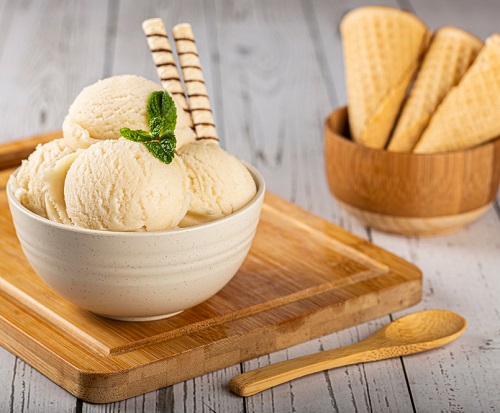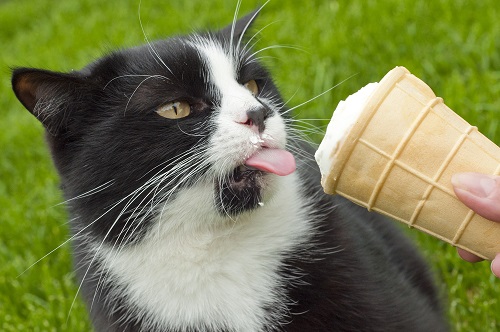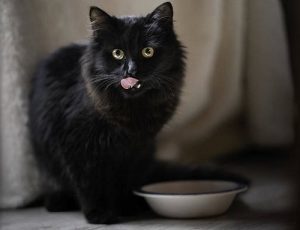Can Cats Eat Vanilla Ice Cream and chill out? Discover the risks and benefits before sharing this frozen treat with your pet.
Imagine sitting on your couch, enjoying a delightful bowl of vanilla ice cream on a hot summer day, when suddenly, your cat approaches with an eager look in its eyes. Before you attempt to share the creamy treat with your pet, find out – Can Cats Eat Vanilla Ice Cream to learn how safe the combination of cats and ice cream is?
Can Cats Eat Croissants? Find out here
What Is Vanilla Ice Cream?

Vanilla ice cream is a popular frozen dessert made from a combination of milk, cream, sugar, and natural or artificial vanilla flavoring. It is typically churned to incorporate air and create a smooth, creamy texture. Vanilla ice cream is a versatile treat that can be enjoyed on its own or used as a base for various toppings and desserts.
Can Cats Eat Vanilla Ice Cream? | Can Cats Have Vanilla Ice Cream?
When it comes to the question – ‘can cats eat vanilla ice cream?’ the answer is not a straightforward “yes” or “no.”
While cats are obligate carnivores, and their diet should primarily consist of meat-based foods, a small taste of vanilla ice cream is unlikely to cause any harm. However, cats are lactose intolerant, meaning they lack the necessary enzymes to digest lactose found in dairy products. Overconsumption of vanilla ice cream could lead to digestive upset and other health issues. That’s why it’s best to avoid feeding vanilla ice cream to felines and instead provide them with appropriate cat-friendly treats.
Is Vanilla Ice Cream Good For Cats?

No, vanilla ice cream is not considered suitable for cats. While it may be tempting to share this frozen treat with your feline companion, always remember that cats have specific dietary needs. Additionally, as obligate carnivores, they need an animal protein-based diet to thrive.
How Is Vanilla Ice Cream Bad For Cats?

- Lactose Intolerance: Most felines are lactose intolerant, meaning they lack the necessary enzymes to digest lactose – the sugar found in milk and dairy products. Vanilla ice cream contains milk and cream, which can lead to digestive upset, including diarrhea, gas, and stomach discomfort in cats.
- High Sugar Content: Vanilla ice cream is high in sugar, which is not a natural component of a cat’s diet. A diet high in sugar can contribute to obesity, diabetes, dental problems, and other health issues in felines.
- Potential Digestive Issues: Cats have sensitive digestive systems, and the rich and fatty nature of vanilla ice cream can be difficult for them to digest properly. This can lead to gastrointestinal distress, such as vomiting and diarrhea.
- Artificial Ingredients: Many commercially available vanilla ice creams contain artificial additives, such as sweeteners, flavorings, and stabilizers, which may not be suitable for cats. These additives can potentially cause gastrointestinal upset or allergic reactions.
- Potential Hazards: Ice cream often contains additional toppings like chocolate, nuts, or fruits, which can be toxic or harmful to cats.
Is Vanilla Toxic To Cats?
Pure vanilla itself is not considered toxic to cats. The vanilla extract or flavoring used in commercial products, such as vanilla ice cream, may contain alcohol and additional ingredients that could be harmful to cats if ingested in large quantities.
Are Cats Allergic To Vanilla?
Cats can be allergic to various substances, and that includes vanilla as well. While pure vanilla is not a common allergen for kitties, commercial vanilla products, such as vanilla extract or flavorings, contain additional ingredients that could trigger an allergic response in sensitive individuals.
Signs Of Vanilla Allergy In Cats
Allergies in cats can manifest in various ways when exposed to vanilla. Here are some signs that may indicate a cat is allergic to vanilla:
- Skin Irritation: Cats with a vanilla allergy may develop skin irritations such as redness, itching, or hives. They may excessively scratch or groom the affected areas.
- Digestive Issues: Digestive problems can occur in cats allergic to vanilla. This may include diarrhea, vomiting, or increased flatulence.
- Swelling: Allergic reactions can cause swelling in cats. This swelling can be seen in various parts of the body, including the face, lips, tongue, or throat.
- Itchy or Watery Eyes: Cats may develop itchy or watery eyes as a result of a vanilla allergy. They may rub their eyes frequently or have discharge from the eyes.
- Behavioral Changes: Some cats may exhibit behavioral changes when they have an allergic reaction. They might become more restless, agitated, or display signs of discomfort.
If you suspect your cat has an allergy to vanilla or any other substance, it’s important to consult a veterinarian
Alternatives to Vanilla Ice Cream
When it comes to providing treats for cats, there are several alternatives to vanilla ice cream that are safer and more suitable for their dietary needs. Here are some options:
- Cat-Specific Treats: Opt for treats that are specifically formulated for cats. These treats are designed to meet their nutritional requirements and often come in a variety of flavors that cats enjoy.
- Frozen Cat Treats: Prepare homemade frozen treats for your cat using cat-friendly ingredients. You can freeze small portions of wet cat food, pureed meats, or even chicken broth in ice cube trays for a cool and tasty treat.
- Plain Frozen Yogurt: Plain, unsweetened yogurt can be a better alternative to ice cream for cats. It contains less lactose and can be enjoyed in small amounts as an occasional treat. However, always check with your veterinarian before introducing any new food to your cat’s diet.
- Freeze-Dried Meat Treats: Freeze-dried meat treats are a healthy option for cats. These treats are made by removing moisture from raw or cooked meats, preserving their flavors and nutrients. They provide a crunchy texture that cats often enjoy.
- Catnip Treats: Many cats are highly responsive to catnip, so providing catnip-infused treats can be an enjoyable and safe option. These treats are typically made with catnip and other cat-friendly ingredients.
Remember, moderation is key when offering treats to cats. It’s important to ensure that treats make up only a small portion of their overall diet, and their primary food should consist of balanced and nutritionally complete cat food.
Can Cats Eat Vanilla Ice Cream? Quick Takeaways
- Vanilla ice cream is a frozen dessert made from milk, cream, sugar, and vanilla flavoring.
- Cats should generally not be given vanilla ice cream as a part of their regular diet.
- Felines are lactose intolerant, and the lactose in ice cream can cause digestive issues like diarrhea and stomach discomfort.
- Vanilla ice cream has a high sugar content, which is not suitable for cats and can lead to obesity and other health problems.
- Cats may have difficulty digesting vanilla ice cream’s rich and fatty nature, leading to digestive upset.
- Commercial vanilla ice creams contain artificial additives that can cause gastrointestinal upset or allergic reactions in felines.
- Additional toppings in ice cream, such as chocolate, nuts, or fruits, can be toxic or harmful to kitties.
- Pure vanilla is not toxic to cats, but commercial vanilla products have harmful ingredients if consumed in large quantities.
- Cats can develop allergies to vanilla or other ingredients of ice cream, resulting in itching, skin irritation, and respiratory issues.
- If you suspect an allergic reaction or observe concerning symptoms after giving your cat vanilla ice cream, consult a veterinarian.



